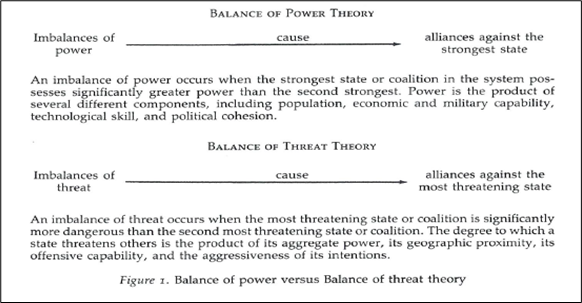Responding to threats
The forces that bring states together and drive them apart will affect the security of individual states by determining both how large a threat they face and how much help they can expect. At the same time, the factors that determine how states choose alliance partners will shape the evolution of the international system as a whole.
Balance of power and balance of threat
According to Walt “the value of balance of threat theory should be viewed as a refinement of traditional balance of power theory”. States balance against the states that pose the greatest threat and the latter need not be the most powerful states in the system. Just as national power is produced by several different components (e.g., military and economic capability, natural resources, and population), the level of threat that a state poses to others is the product of several interrelated components.
Whereas balance of power theory predicts that states will react to imbalances of power, balance of threat theory predicts that when there is an imbalance of threat (i.e., when one state or coalition appears especially dangerous), states will form alliances or increase their internal efforts in order to reduce their vulnerability.
The principal concept that informs balance of power theory is power, which consists of components such as military and economic capability and population. The principal concept that informs balance of threat theory is threat, which consists of aggregate power, proximity, offensive capability, and perceived intentions. (Walt 1987)
The distinction is subtle but important. Balance of threat theory improves on balance of power theory by providing greater explanatory power. By using balance of threat theory, we can understand a number of events that we cannot explain by focusing solely on the distribution of aggregate capabilities.
Finally, balance of threat theory can also explain alliance choices when a state’s potential allies are roughly equal in power. In such a circumstance, a state will ally with the side it believes is least dangerous. Aggregate power is an important component of threat, but not the only one. By conceiving of alliances as responses to imbalances of threat (not just imbalances of power), more complete and accurate picture of behavior in the international political realm can be achieved.
In Figure 1 below, the main features of balance of threat theory and balance of power theory.

(Walt 1987)
How states respond to threats
Do states seek allies in order to balance a threatening power or are they more likely to bandwagon with the most threatening state? The answer depends on whether states most often ally to oppose a threatening power or try to appease it.
The states ally to balance against threats rather than against power alone. Although the distribution of power is a very important factor, the level of threat is also affected by geographic proximity, offensive capabilities, and perceived intentions.
When confronted by a significant external threat, states may either balance or bandwagon. Thus, two distinct hypotheses about how states will select their alliance partners can be identified on the basis of whether the states ally against or with the principal external threat. (Walt 1987)
Balancing Behavior
Balancing is defined as allying with others against the prevailing threat. States choose to balance for two main reasons. First, they place their survival at risk if they fail to curb a potential hegemon before it becomes too strong. Second, joining the weaker side increases the new member’s influence within the alliance, because the weaker side has greater need for assistance. Allying with the stronger side, by contrast, gives the new member less influence.
Bandwagoning Behavior
Bandwagoning refers to alignment with the source of danger. The more powerful the state and the more clearly this power is demonstrated, the more likely others are to ally with it. States are attracted by strength. The belief that states are prone to bandwagoning implies that most alliances are extremely fragile. By joining the side that bandwagoning states believe would triumph, each hoped to make territorial gains at the end of the fighting.


